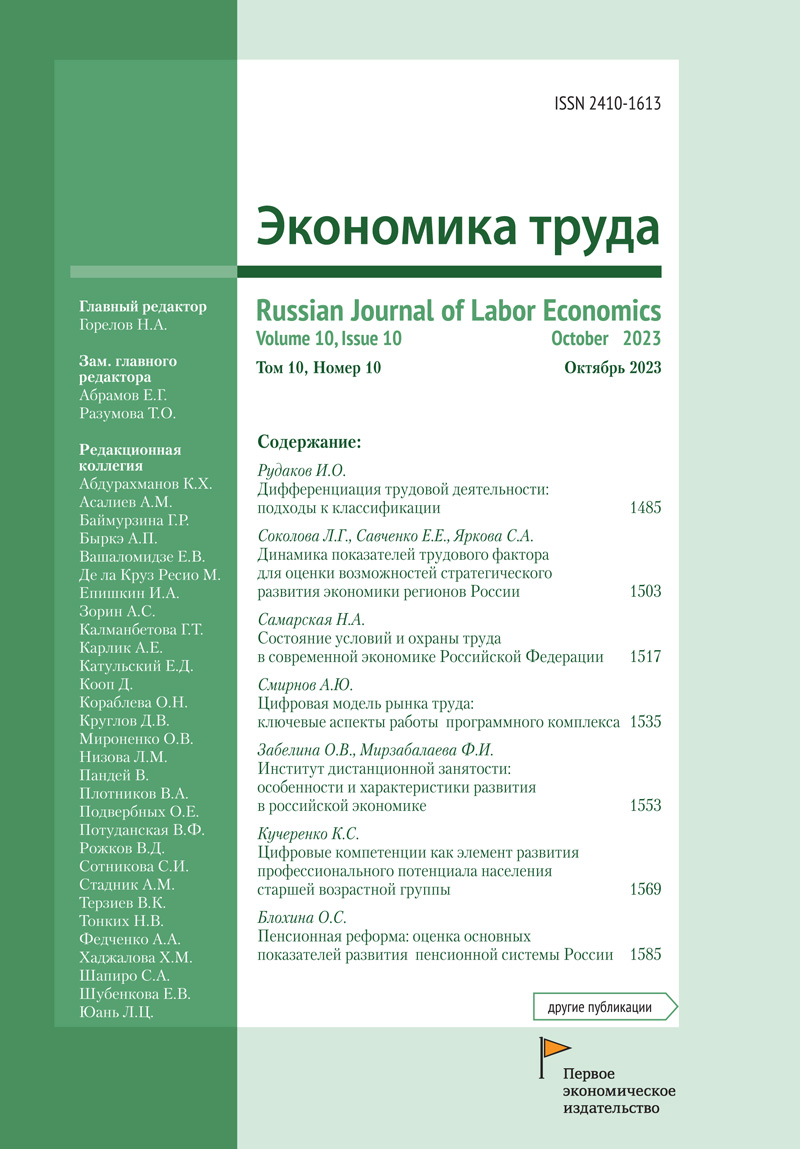Differentiation of labor activity: approaches to classification
- Authors: Rudakov I.O.1
-
Affiliations:
- Plekhanov Russian University of Economics
- Issue: Vol 10, No 10 (2023)
- Pages: 1485-1502
- Section: Articles
- URL: https://journals.eco-vector.com/2410-1613/article/view/625102
- DOI: https://doi.org/10.18334/et.10.10.119308
- ID: 625102
Cite item
Abstract
The digitalization of the economy, as well as the spread of artificial intelligence and automation technology, lead to a change in the content of work and labor. In this regard, there is a need for such approaches to the characteristics of labor that would help to analyze the changes taking place.The research goal was to identify the main types of labor classification in different historical periods, which would allow assessing the impact of technology on labor. To achieve this goal, it is necessary to consider existing approaches to the classification of labor, formulate criteria for the main types of classification, propose the main types of classification, and provide justification for the selected criteria and types of classification.Various approaches to the classification of labor were considered; the goals and context of these approaches were identified. The basis of classification was revealed. On the basis of the considered approaches, the criteria of the main types of labor classification were formulated; and the choice and formulation of the proposed criteria were justified. Finally, four main types of labor activity characteristics were proposed.The article will be of interest to researchers of the impact of technology on labor.Acknowledgments:The study was carried out with the financial support of the Russian National Science Foundation grant No. 23-28-00358 "Institutional and structural conditions for adaptation to shocks of economic development".
About the authors
Igor Olegovich Rudakov
Plekhanov Russian University of Economics
Email: thefirstrudakov@gmail.com
References
- Белл Д. Грядущее постиндустриальное общество. Опыт социального прогнозирования. - Москва: Academia, 2004. – 944 c.
- Блауг М. 100 великих экономистов до Кейнса. / Библиотека «Экономической школы», вып. 42. - СПб.: Экономикус, 2009. – 128-130(352) c.
- Веблен Т. Теория праздного класса. - Москва: АСТ, 2021. – 384 c.
- Григорова Я.В., Гриценко В.С. Концепция нематериального труда в философии постопераизма и её критика // Вестник Пермского университета. Философия. Психология. Социология. – 2016. – № 2(26). – c. 39-44. – doi: 10.17072/2078-7898/2016-2-39-44.
- Кастельс М. Информационная эпоха: экономика, общество и культура. - Москва: Изд. дом ГУ ВШЭ, 2016. – 606 c.
- Маркс К. Капитал. - Санкт-Петербург: Лениздат, 2019. – 512 c.
- Минцберг Г. Структура в кулаке. - СПб.: Питер, 2007.
- Перспективы занятости и социальной защиты в мире: Роль платформ цифрового труда в трансформации сферы труда. Международная Организация Труда. [Электронный ресурс]. URL: https://www.ilo.org/wcmsp5/groups/public/---europe/---ro-geneva/---sro-moscow/documents/publication/wcms_829515.pdf (дата обращения: 17.06.2023).
- Тоффлер Э. Третья волна. - Москва: АСТ, 2010. – 800 c.
- Устюжанина Е.В., Евсюков С.Г., Сигарев А.В., Устюжанин В.Л. Трансформация рынка труда: влияние пандемии и прогнозы на будущее // Вестник Московского университета. Серия 6: Экономика. – 2021. – № 1. – c. 77-102.
- Устюжанина Е.В., Сигарев А.В., Шеин Р.А. Цифровая экономика как новая парадигма экономического развития // Национальные интересы: приоритеты и безопасность. – 2017. – № 10. – c. 1788-1804. – doi: 10.24891/ni.13.10.1788.
- Хабибуллина З.Р. Творческий труд: специфика, динамика развития и характеристика системной трансформации // Экономическая наука современной России. – 2020. – № 1(88). – c. 32-40. – doi: 10.33293/1609-1442-2020-1(88)-32-40.
- Чатери С. Постиндустриализм и движение искусств и ремесел: между Британией, Индией и Соединенными Штатами Америки. British Art Studies. [Электронный ресурс]. URL: https://britishartstudies.ac.uk/issues/issue-index/issue-15/postindustrialism-and-the-long-arts-and-crafts-movement (дата обращения: 17.06.2023).
- Acemoglu D., Restrepo P. Robots and Jobs: Evidence from US Labor Markets. NBER Working Paper. [Электронный ресурс]. URL: https://www.nber.org/system/files/working_papers/w23285/w23285.pdf.
- Marshall A. Principles of Economics. The Online Library of Liberty. [Электронный ресурс]. URL: https://eet.pixel-online.org/files/etranslation/original /Marshall,%20Principles%20of%20Economics.pdf (дата обращения: 21.08.2023).
- Charles L., Théré C. Charles Richard de Butré: an economist in the shadow of françois quesnay // Journal of the History of Economic Thought. – 2016. – № 2. – p. 131-152. – doi: 10.1017/S1053837216000055.
- Dillender M., Forsythe E. Computerization of White Collar Jobs. Upjohn Institute Working Paper. [Электронный ресурс]. URL: https://research.upjohn.org/cgi/viewcontent.cgi?article=1328context=up_workingpapers.
- Marinoudi V., Lampridi M., Kateris D., Pearson S., Sørensen C.G., Bochtis D. The Future of Agricultural Jobs in View of Robotization // Sustainability. – 2021. – № 13. – p. 12109. – doi: 10.3390/su132112109.
- Martens B., Tolan S. Will This Time Be Different? A Review of the Literature on the Impact of Artificial Intelligence on Employment, Incomes and Growth. JRC Digital Economy Working Paper. [Электронный ресурс]. URL: https://ssrn.com/abstract=3290708 (дата обращения: 17.06.2023).
- Smith A., Spencer M.G. Wealth of nations. - London: Wordsworth Editions Ltd., 2012. – 1008 p.
Supplementary files









